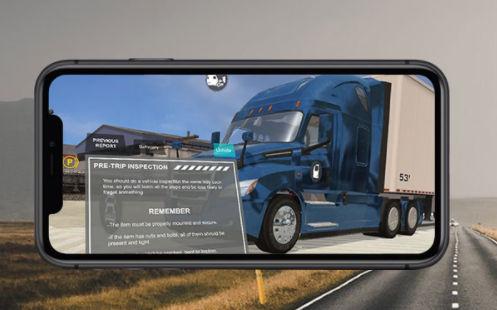Advanced Realistic Simulation Enhances Training for Tomorrow’s Truckers

Simulators mimic how a truck behaves—including weight, torque, and field of vision, among other factors
Economic recovery in the post-COVID-19 era, says John Kearney, CEO of Advanced Training Systems, could be severely hampered by a growing shortage of truck drivers. It is estimated that there are 50,000 fewer long- and short-haul truckers than are needed now, a total that, if nothing changes, could reach 160,000 by 2028.(1) Kearney, whose company is a leading designer and manufacturer of virtual simulators for driver training, among other applications, notes that over 70% of all freight in the U.S. moves by truck(2), and that average driver age in the over-the-road trucking industry is close to fifty(1).
“Trucking,” says Kearney, “is a key component of the American economy. To continue effectively serving the nation’s supply chain, the trucking industry needs to recruit an army of young, well-trained new drivers.” Essential to the proper training of these new drivers, he notes, is virtual-reality simulation. Studies show a crash reduction rate of up to 35% for simulator-trained truck drivers; they also show that simulator training lowers overall training cost by accelerating students’ progress.(3)
ATS, an acknowledged leader in virtual reality technology, deploys a number of patented processes designed to further these goals. Among them is the On QTM simulation motion device, which provides haptic feedback in the form of longitudinal motion cues for accelerating and braking, and lateral cues for turning, thus giving the student the sense of a real driving experience.
This capability, notes Kearney, is particularly useful as truck driver training begins to look to an electrical future: While the first production-model electric trucks will not be delivered until late 2021, environmental concerns will make them an increasingly important part of the overall supply chain.(4)
Because of the weight of the battery, electrical trucks, particularly in curves and turns, do not respond in exactly the same way as diesels. Training for these vehicles will need to be incorporated into the overall driver training process, which is increasingly being managed not by third parties but by the shippers themselves. ATS, notes Kearney, is in discussion with at least one very major shipper about in-house use of its simulator technology.
Meanwhile, heavy-duty electrical truck testing is now being conducted at the Ports of Los Angeles and Long Beach, where about 14,000 trucks per day pass through the complex.(5) ATS, which has a development center at Vista, CA, has been involved in some of the training being done, both onsite at the port and at nearby San Bernardino Valley College.
“We’re proud of being at the forefront of driver training support technology,” says Kearney, “and we look forward to further assisting the industry as it evolves. Our overall goal is to leverage our technology and experience so as to produce more skillful, safer, and better-prepared drivers—regardless of how their vehicles are powered.”
Category: Driver Stuff, Featured, General Update, News, Tech Talk, Training










